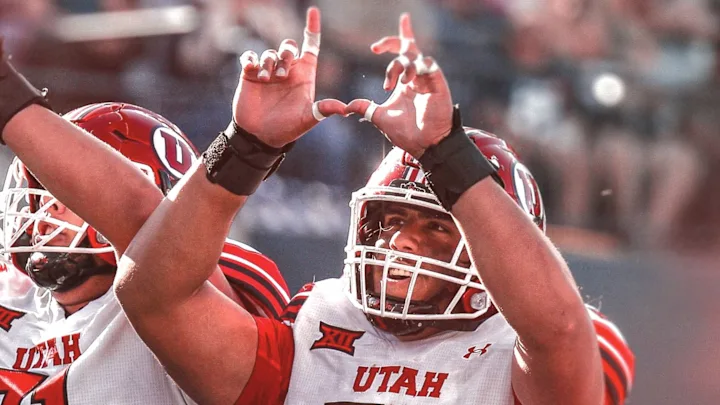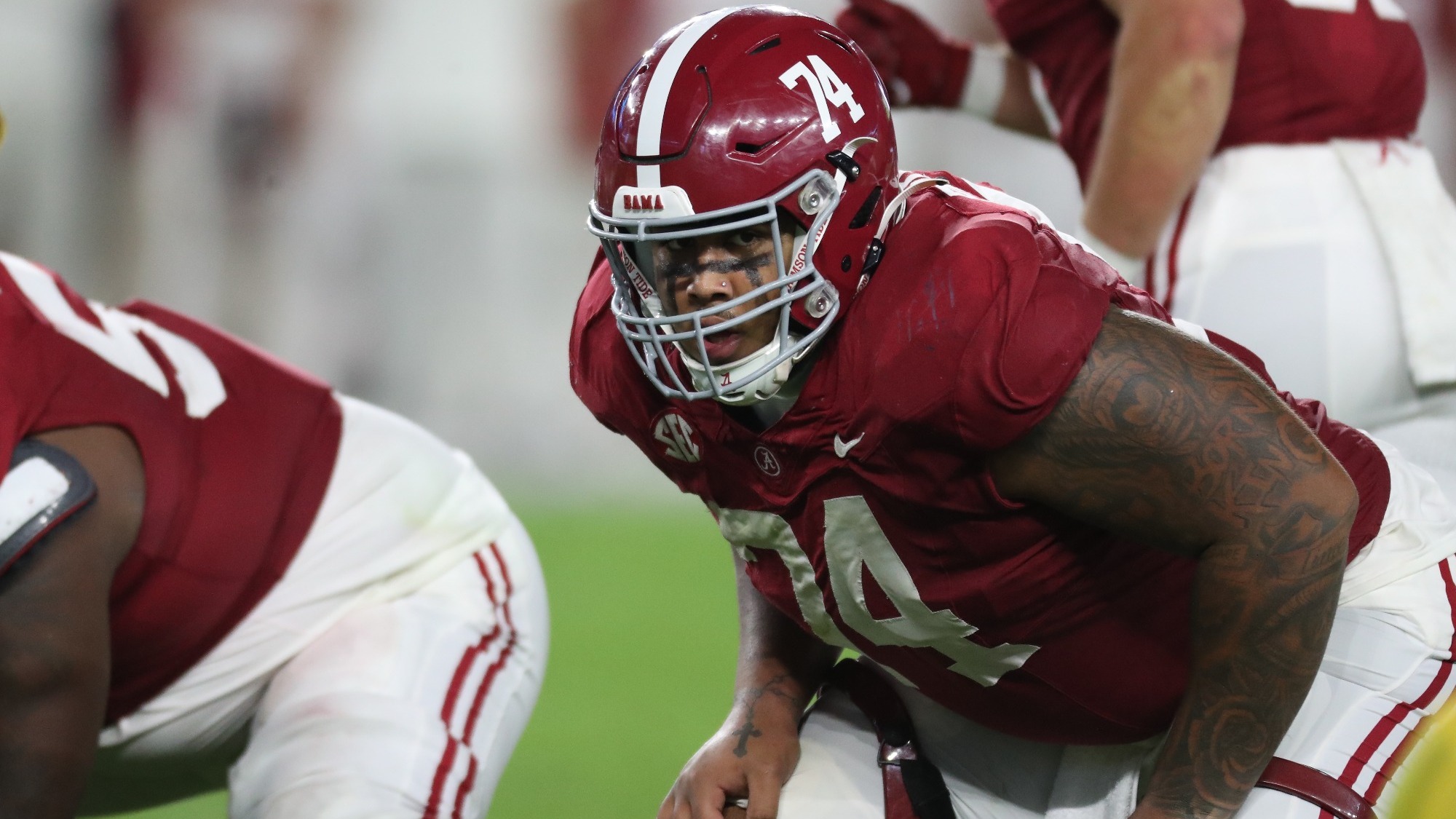By Charlie Campbell.
Send Charlie an e-mail here: [email protected]
Follow Charlie on Twitter @draftcampbell for updates.
This page was last updated March 28, 2014. Follow me @walterfootball for updates.
Position Review: Guards
Guard Class
Early-round talent: B+
Mid-round: B
Late-round: C+
Overall grade: B
2014 prospects vs 2013
Xavier Su’a-Filo < Jonathan Cooper
David Yankey < Chance Warmack
Brandon Thomas < Kyle Long
Gabe Jackson < Larry Warford
Cyril Richardson > Brian Winters
Chris Watt < Dallas Thomas
Anthony Steen < Hugh Thornton
Trai Turner < Edmund Kigbila
Guard was one of the strongest positions in the 2013 draft class. There was rare, once-in-a-decade elite talent for Round 1 as well as good players for the second day of the 2013 NFL Draft. There were pundits who believed that Warmack was the best overall prospect in the draft while Cooper was the seventh-overall pick. Three guards went in the top-20 picks, while some teams had a first-round grade on Warford.
If you were to merge the two classes, it wouldn’t look good for 2014. Su’a-Filo would go ahead of Warford, but they’re pretty equal as prospects. In this writer’s opinion, if Warford were in the 2014 NFL Draft, he would be a late first-rounder and the first guard selected. Yankey, Thomas, Jackson and Richardson would go behind Warford and ahead of Winters. Watt would go behind Thornton. Steen and Turner would go behind the fourth-round pick, Kigbila. The 2014 class should produce some quality guards for the NFL with good starting talent, but the 2013 NFL Draft had a rare group of guard talent.
Safest Pick: Xavier Su’a-Filo, UCLA

The only guards who have a real shot to be a first-round pick this year are Xavier Su’a-Filo and David Yankey. I think Su’a-Filo is the safer selection because he is a better, more versatile athlete. He developed his pass-protection skills with a lot of time at left tackle in his collegiate career. Su’a-Filo also has good size and strength to be a productive run-blocker. He can fit any offense. Su’a-Filo should be a quick, long-term starter in the NFL.
Biggest Bust Potential: Chris Watt, Notre Dame

Last year, I chose Brian Winters for this category. He turned out to be a massive disappointment for the Jets, but maybe he’ll be better in his second season. This year was a tough call; no player is screaming bust to me. Being forced to pick one, I have to go with Watt. Part of that is based on his junior season when he really struggled in pass protection, look at what Panthers defensive tackle Kawann Short (Purdue) did to him. In the NFL, I think Watt should be a solid run-defender, but I could see him having problems with interior speed rushers.
Guard Rankings by Attributes
Pass Protection:
NFL prototype: Jahri Evans, Saints
- Xavier Su’a-Filo
- Brandon Thomas
- David Yankey
- Cyril Richardson
- Anthony Steen
- Trai Turner
- Gabe Jackson
- Chris Watt
Recap: The NFL is a passing-driven league, so keeping a clean pocket as a pass-blocker is the attribute that the majority of teams consider first. Coaches want the guards to keep defensive tackles from gaining penetration or causing disruption. If the guards are successful, quarterbacks can step up in the pocket to avoid edge rushers. This helps out the offensive tackles significantly. Plus, good guard play provides better throwing lanes for the quarterback. This is why the Saints are one team that invests more money in guards instead of tackles.
Su’a-Filo is extremely quick and athletic. He was an asset as a pass-blocker in college, and pass protection should be his biggest strength in the NFL. After taking on fast edge rushers, interior speed rushers seem slow to Su’a-Filo. He also has a strong base to anchor against heavy bull rushers. Su’a-Filo’s strength, speed and athleticism allow him negate whatever is thrown at him.
Thomas also was a college left tackle who should be very effective as an interior pass-protector. He is quick and athletic with the size to function on the inside.
Yankey is generally strong in pass protection, but he is prone to some lapses. There were times when Yankey would get beaten and allow his quarterback to get hit. There were players who bested Yankey who he shouldn’t have struggled with.
At Baylor, Richardson struggled as the left tackle during Robert Griffin III’s final season. As a guard, Richardson was much improved as a junior or senior. However, he was dominated at the Senior Bowl by Aaron Donald, which showed that Richardson needs work as a pass-protector. His tape was better.
Steen improved his pass blocking over the last couple of years, but he still has more to go for the NFL. Turner and Jackson are better run-blockers, but they aren’t liabilities in pass protection. Turner has some quickness and upside to develop. As stated above, Watt could have issues in pass protection. He got better as a senior, but he may need time to develop before starting in the NFL.
Run Blocking:
NFL prototype: Mike Iupati, 49ers
- David Yankey
- Gabe Jackson
- Cyril Richardson
- Trai Turner
- Anthony Steen
- Xavier Su’a-Filo
- Chris Watt
- Brandon Thomas
Recap: Guards are the engine of a good running game. They are the most important blockers for opening holes up the middle in addition to pulling or moving on stretch runs. Dominant guards who can open up holes even when defenses know the run is coming provide a mental edge, especially late in games. This is a strong class of run-blockers.
Yankey was an asset as a run-blocker for Stanford. While some of the players behind him have more power, Yankey has more versatility in the types of ways he can open up holes. Yankey is great at pulling from left guard. He fires to the second level and can drive block. Yankey can do it all.
Jackson and Richardson are powerful maulers in the ground game. They both can push blockers out of their gaps to open holes for their back. Lache Seastrunk had a lot of success running behind Richardson at Baylor.
Turner and Steen are good run-blockers. Both LSU and Alabama could rely on running behind them in their ground-based offenses.
Su’a-Filo is solid in run blocking as well. He could be rated higher, but the other players have more shear power. Watt blocked well for Notre Dame in the ground game the past couple of seasons. That’s his best strength. Thomas will need to develop his interior run blocking as he moves from tackle to guard.
Speed:
NFL prototype: Jahri Evans, Saints
- Xavier Su’a-Filo
- Brandon Thomas
- Trai Turner
- David Yankey
- Chris Watt
- Anthony Steen
- Gabe Jackson
- Cyril Richardson
Recap: Speed helps guards to hit blocks on the second level and while pulling. Zone-blocking schemes require their guards to have good quickness to set up runs.
Su’a-Filo is the fastest guard in the 2014 NFL Draft. He fires out of his stance and gets on defenders before they’re ready. Su’a-Filo uses his speed to win at the second level. He is extremely skilled at hitting blocks in space due to how fast he is and his athletic ability. During his career, Su’a-Filo could be one of the quicker interior linemen in the NFL.
Thomas is fast as well. He is quick to the second level, and his speed will help him in his position change.
Turner has some quickness and gets on defenders faster than one would think. He showed impressive speed at the Combine with one of the faster 40 times among the offensive linemen. Quickness and athleticism are part of Turner’s nice upside for the NFL.
Yankey has quickness as a puller and getting to blocks on the second level. He spent time at tackle in his college career. Watt and Steen aren’t blazers, but they aren’t slow either. Both have enough quickness to get the job done.
Jackson and Richardson seem to have heavy feet and don’t move around that well. They each need to improve on their respective speed to the second level for the NFL.
Strength:
NFL prototype: Carl Nicks, Buccaneers
- Cyril Richardson
- Gabe Jackson
- Anthony Steen
- Trai Turner
- Xavier Su’a-Filo
- David Yankey
- Chris Watt
- Brandon Thomas
Recap: There is no substitute for power at the point of attack. All of the top guards in the NFL have it. The strength to push linemen out of their gaps results in positive yards on the vast majority of plays.
Richardson and Jackson are about equal as the most powerful guards in this draft class. They are both mammoth linemen with huge upper bodies to push defensive tackles around. Richardson can get linemen on roller skates and toss them aside. Jackson has used his strength to sustain his blocks as long as he deems acceptable. Strength is both an asset of theirs entering the NFL.
Steen and Turner aren’t that far behind. Each can blast open holes with strength and push defenders around at the point of attack. Turner looks like he has room to expand in his upper body and get more powerful for the NFL.
Su’a-Filo and Yankey aren’t weak by any means. Both have enough strength to be effective in the NFL, but each one of them could use a little more power in their respective games. Having played tackle in college, both players had to stay leaner and athletic for the edge, so Su’a-Filo and Yankey could add weight for the pros. If you re-ranked this category in a few years, it wouldn’t surprise me if both of these players were higher.
Watt and Thomas aren’t weak, but they could use more functional strength for the NFL.
Zone Blocking:
NFL prototype: Wade Smith, Texans
- Xavier Su’a-Filo
- Brandon Thomas
- David Yankey
- Anthony Steen
- Chris Watt
- Trai Turner
- Cyril Richardson
- Gabe Jackson
Recap: The zone-blocking system is run by a number of NFL teams, and the success of the scheme has many power-man teams adding some zone plays into the playbook. The zone scheme calls for guards to have the ability to move well laterally and downfield to help set up moving wall with cut-back lanes. Guards need the athleticism and quickness in order to be effective.
Su’a-Filo is a perfect fit in a zone-blocking scheme. He is sufficiently fast and athletic to be part of the moving well. Thomas is very well suited to a zone scheme because of his quickness and athleticism. Both Su’a-Filo and Thomas would fit well in a zone scheme.
Yankey, Steen and Watt all executed well in zone blocking during their collegiate careers. All three enter the NFL with some quality experience for zone blocking in the pros. They were well coached and each should be able to adjust quickly if drafted by a team that runs a lot of zone. Yankey is quicker and more athletic than the other two, thus he’s rated ahead of them.
Richardson and Jackson have heavy feet. They may not quick enough for a zone system in the NFL.
Power Man:
NFL prototype: Marshall Yanda, Ravens
- David Yankey
- Xavier Su’a-Filo
- Cyril Richardson
- Gabe Jackson
- Trai Turner
- Anthony Steen
- Chris Watt
- Brandon Thomas
Recap: A lot of teams in the NFL run a power man-blocking scheme. Guards for this scheme need the ability to defeat their defender to blast open or seal a running lane. Guards need to have the power to move defenders and sustain blocks.
Yankey and Su’a-Filo aren’t as strong as some of the other linemen, but they are excellent technicians. Both are strong enough and also can get to spots and hit isolation blocks in space.
Some of the stronger linemen, like Richardson and Jackson, aren’t as nimble to hit blocks in space. However, they do have the power to move defenders at the point of attack. Jackson and Richardson both would fit best in a power man-blocking scheme in the next level.
Turner was a quality man-blocker at LSU. Jeremy Hill had success running behind Turner last year. Turner could use more grooming for the next level and probably should have returned for his senior year.
Steen and Watt are strong enough for man blocking. Alabama did more of it than Notre Dame, thus Steen is ranked ahead of Watt.
Thomas came from a spread offense in college. Between the offense and position change, he will need more development for a man-blocking scheme in the NFL.
Versatility:
NFL prototype: Logan Mankins, Patriots
- Brandon Thomas
- Xavier Su’a-Filo
- Cyril Richardson
- David Yankey
- Anthony Steen
- Chris Watt
- Trai Turner
- Gabe Jackson
Recap: A lot of NFL offensive line coaches want to crosstrain their interior linemen for another position, especially among the backup offensive linemen. It helps teams in making the decision on who to keep active on game days. Linemen who can play more than one position are highly valued. Coaches like guards who can play center or tackle if there is an injury during a game.
Thomas’ speed and athleticism have him as the most versatile. After being Tajh Boyd’s left tackle last year, Thomas will probably be a guard in the NFL because of his size, although some think he could remain at tackle. WalterFootball.com spoke with scouts who feel Thomas will be a guard who could move to tackle only if there’s an injury. The 6-foot-3, 316-pounder is so quick and athletic it wouldn’t be surprising if some think of training him at center. Thomas could conceivably play tackle, guard or center, therefore he’s the most versatile.
As previously stated, Su’a-Filo played tackle and guard in college. He was a starter at left tackle and could play there if there was an injury, but Su’a-Filo will fit best at guard in the NFL.
Richardson and Yankey played tackle and guard in college. Both could get consideration in the NFL at right tackle, but they should stay inside. Richardson has the size of some starting right tackles, so he would fit that better, and thus he’s rated ahead of Yankey.
Steen, Watt, Turner and Jackson all are guards for the NFL. If given some lead time, Steen could maybe learn center – but that would be for emergencies only.
Pulling:
NFL prototype: Ben Grubbs, Saints
- Xavier Su’a-Filo
- David Yankey
- Anthony Steen
- Chris Watt
- Trai Turner
- Brandon Thomas
- Gabe Jackson
- Cyril Richardson
Recap: Pulling is absolutely necessary for a man-blocking system to work. Zone teams are becoming more diverse and are mixing in more power-man plays that have guards pulling. The quick and athletic guards of zone schemes do better pulling than isolating and charging straight ahead. Thus, a zone team will like to see a prospect’s ability to pull as well.
Su’a-Filo didn’t get to pull as much in college because he spent so much time at left tackle, but in the NFL, he could develop into a superb pulling guard. Su’a-Filo is so agile, quick and balanced in his approach that he could be devastating.
There were games that Yankey was flat out awesome at pulling; just ask Oregon. He is quick to bend around the line and blast a hole open. There were other contests that Yankey wasn’t as effective, but still he is very adept at pulling. It should be a quick asset of his game in the NFL.
Steen pulled well for Alabama the past few seasons, and he should continue to be effective in the NFL. Steen is ranked below the top two because he played on the right side and players on that side don’t pull as much as linemen on the left side of the line.
Watt did a nice job of pulling for Notre Dame. Turner was more of a downhill blocker, but he has the quickness and athletic ability to pull. Turner could develop into a starting left guard in the NFL.
Thomas has the athletic ability and quickness to do well when he pulls. Thomas could use more experience, but he should improve this skill in the NFL.
Jackson and Richardson need work to become more effective at pulling for the pros. Both did well in college, but could stand to get lighter and quicker if called on to do it in the NFL. The holes close quickly at the next level with the speed of linebackers, linemen and safeties. Jackson and Richardson will need to improve that skill for the next level.
NFL Picks - Dec. 19
NFL Power Rankings - Dec. 17
2026 NFL Mock Draft - Dec. 17
Fantasy Football Rankings - Sept. 1



